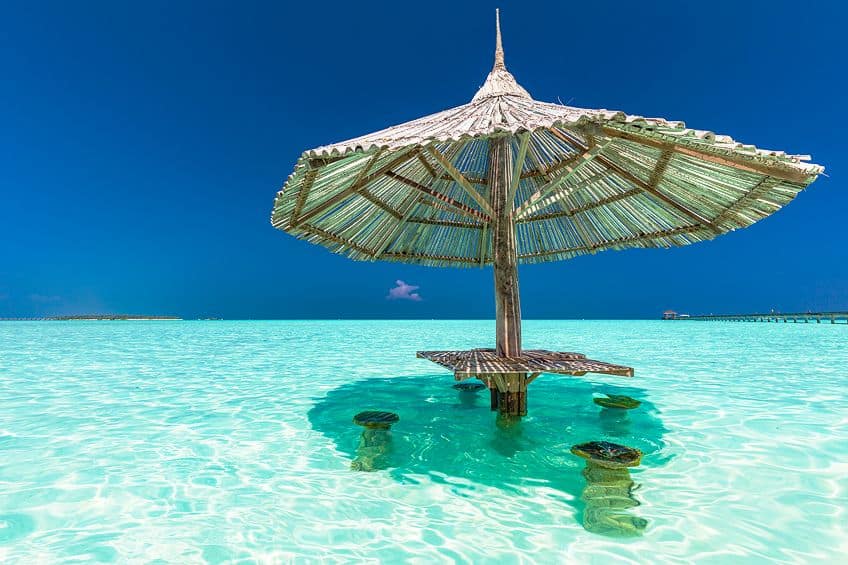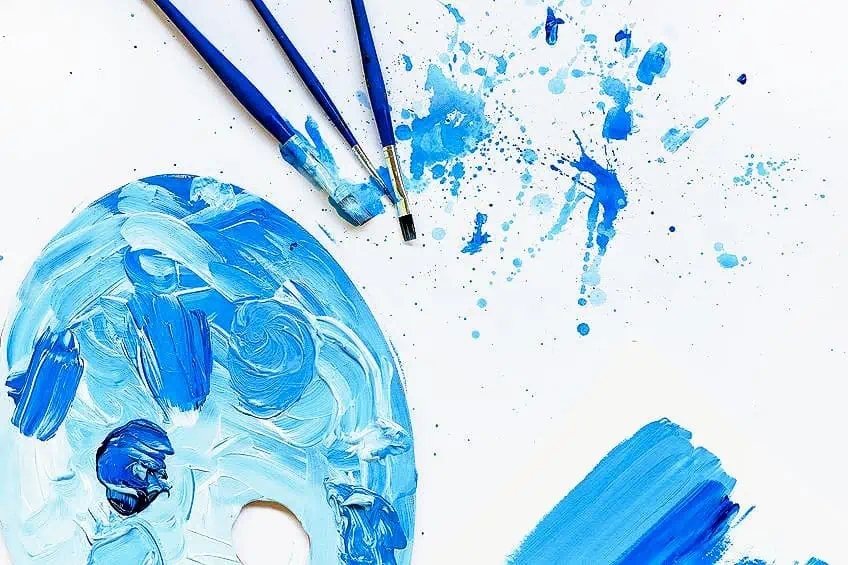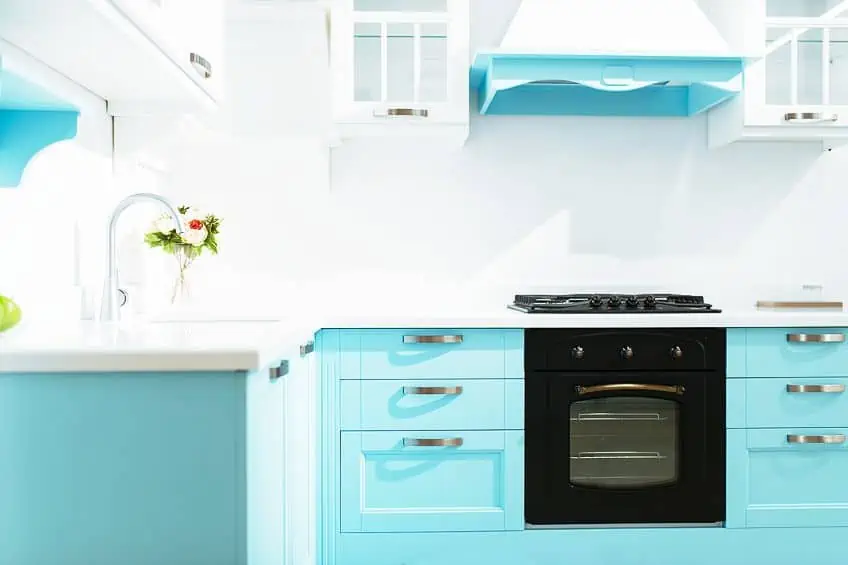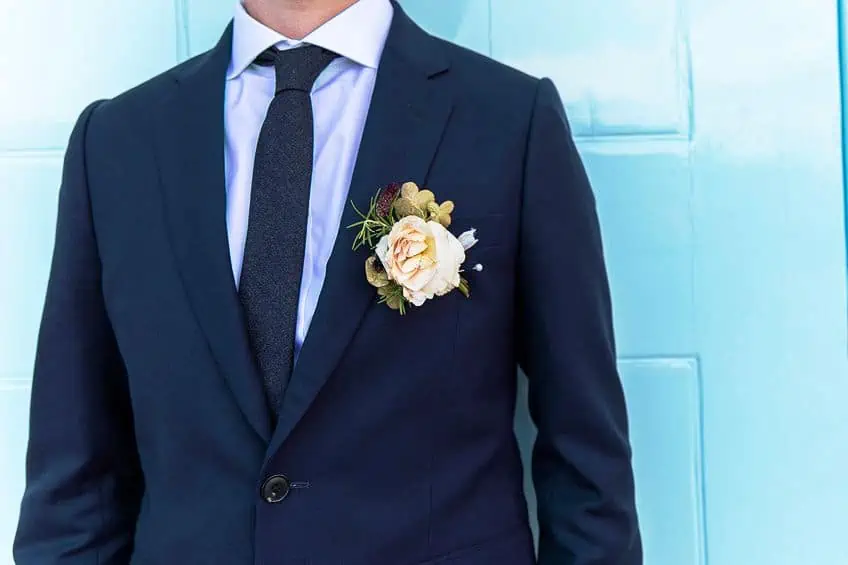Shades of Blue – Learn All There Is to Know About Shades of Blue
Blue, the color of our skies and seas, is a mesmerizing hue that has captured the wide-eyed gaze of people for centuries. Its peaceful demeanor provides some peace to our senses, leading to it becoming a common occurrence in fields like fashion, art, and interior design. However, in order to utilize the countless different shades of blue to their fullest potential, one must first come to understand the color blue, its history, its effect on our psyche, and how it can be used to convey our ideas and emotions through our own works. So, join us as we come to discover the many types of blue shades, blue hex codes, what colors make blue, how to make blue paint for ourselves, and much more!
The History of Blue and Its Many Shades
As a color that has become rooted in associations with our sprawling skies and endless seas, it should come as no surprise that the history of the color blue and its many shades is often just as vast and fascinating. The story of blue spans across thousands of years, dating back to its origins in ancient Egypt through to its use in the art and design of our modern day. The many types of blue shades have taken hold of artists throughout time, cultures, and locations. In ancient Egypt, blue was a significant color that was used to symbolize the heavens, as well as the Nile River. The Egyptians had discovered how to create a synthetic blue pigment, which would go on to be known as Egyptian Blue. Their process included the heating of copper, limestone, and sand, which would create a vibrant hue that was used extensively throughout their art and architecture and would become highly valued for its striking beauty.
Moving into the Middle Ages, blue would go on to become a rare and expensive color, one that only the wealthy and powerful could afford and obtain.
The process of creating blue dyes from natural sources, such as indigo and woad, was labor-intensive and time-consuming, making blue garments a luxury item. The famous ultramarine blue pigment, made from lapis lazuli, a rare and expensive stone imported from Afghanistan, was highly coveted by artists and patrons alike. The Renaissance would go on to bring with it a renewed interest in art and science, and blue became more widely available as trade routes expanded and new methods of creating blue dyes were discovered. Cobalt blue, made from a mineral found in the earth, was a popular choice for painters and ceramicists. The Dutch also developed a process for creating a vibrant blue dye called Delft blue, which became a hallmark of their pottery.
| Blue Name | Blue Hex Codes | RGB | CMYK Color Code (%) | Shades of Blue |
| Blue | #0000ff | 0, 0, 255 | 100, 100, 0, 0 | |
| Cobalt Blue | #0047ab | 0, 71, 171 | 100, 58, 0, 33 | |
| Dark Blue | #00008b | 0, 0, 139 | 100, 100, 0, 45 | |
| Light Blue | #add8e6 | 173, 216, 230 | 25, 6, 0, 10 | |
| Lapis Lazuli | #26619c | 38, 97, 156 | 76, 38, 0, 39 | |
| Delft Blue | #3311ee | 51, 17, 238 | 79, 93, 0, 7 | |
| Prussian Blue | #003153 | 0, 49, 83 | 100, 41, 0, 67 | |
| Egyptian Blue | #1434a4 | 20, 52, 164 | 88, 68, 0, 36 | |
| Phthalo Blue | #000f89 | 0, 15, 137 | 100, 89, 0, 46 | |
| Baby Blue | #89cff0 | 137, 207, 240 | 43, 14, 0, 6 | |
| Navy Blue | #000080 | 0, 0, 128 | 100, 100, 0, 50 |
The Renaissance would go on to bring with it a renewed interest in art and science, and blue became more widely available as trade routes expanded and new methods of creating blue dyes were discovered. Cobalt blue, made from a mineral found in the earth, was a popular choice for painters and ceramicists. The Dutch also developed a process for creating a vibrant blue dye called Delft blue, which became a hallmark of their pottery. Fast forward to the 19th century, when the invention of synthetic dyes revolutionized the textile industry, making blue more affordable and accessible to the masses.
Blue pigments such as Prussian blue and Phthalo blue were also invented during this time, further expanding the range of shades that were made available to the public.
Today, blue remains one of the most popular colors in the world, with a vast spectrum of shades and tones that continue to inspire and captivate us. From the calming baby blue to the dramatic and intense navy blue, the many shades of blue have played a significant role in shaping the history, cultures, and aesthetics of the world around us. The history of the many shades of blue is a testament to its enduring appeal and timeless beauty, a color that has touched the hearts and minds of people for generations, and one that will continue to do so for generations to come.
The Psychological Effects of Blue Shades
The many different shades of blue have long been closely knit with feelings of peace, contemplation, and serenity. From the soft, soothing hue of baby blue to the deep, contemplative tone of navy blue, each shade of blue has its own unique psychological effect on the human mind. Studies have shown that exposure to blue light can help to regulate our circadian rhythm and improve our sleep quality. The soft, pale blue of a morning sky can evoke feelings of tranquility and help to start our day off on the right foot.
Similarly, the calming effect of blue has been harnessed in various therapies, including color therapy and chromotherapy. Blue is regularly seen in such forms of therapy to promote relaxation, while reducing stress and anxiety-related symptoms and improving one’s overall mental health.
However, not all shades of blue have a calming effect. The simply energizing hue of electric blue can evoke emotions similar to enthusiasm while promoting creativity. This shade of blue is often used in fashion and design to add a pop of color and inject some personality into a space. On the other hand, the darker shades of blue, such as navy blue and royal blue, are associated with sophistication, authority, and stability.
These shades of blue are often used in business and politics to convey a sense of professionalism and trustworthiness. In art and design industries, blue is able to offer its users with a versatile palette that can promote a myriad of moods and emotions. Whether it is the cool, refreshing feeling of a clear blue sky or the dark, mysterious mood of a deep blue ocean, the psychological effects of the many shades of blue are as varied and nuanced as the color itself.
Using Shades of Blue in Art and Design
The many shades of blue offer a versatile palette that can be used in art and design to convey a variety of emotions and moods. From the calming, serene feeling of a soft baby blue to the bold, dramatic impact of a deep indigo blue, each shade has its own unique traits and potential for artistic expression.
| Blue Name | Blue Hex Codes | RGB | CMYK Color Code (%) | Shades of Blue |
| Baby Blue | #89cff0 | 137, 207, 240 | 43, 14, 0, 6 | |
| Indigo Blue | #3f00ff | 63, 0, 255 | 75, 100, 0, 0 |
In interior design, blue is often used to create a sense of tranquility and relaxation. Soft shades of blue, such as powder blue, can be used to create a soothing atmosphere in bedrooms and bathrooms. On the other hand, the more intense shades of blue, such as cobalt blue and turquoise, can add a pop of color and energy to living spaces and kitchens.
| Blue Name | Blue Hex Codes | RGB | CMYK Color Code (%) | Shades of Blue |
| Powder Blue | #b0e0e6 | 176, 224, 230 | 23, 3, 0, 10 | |
| Cobalt Blue | #0047ab | 0, 71, 171 | 100, 58, 0, 33 | |
| Turquoise | #40e0d0 | 64, 244, 208 | 71, 0, 7, 12 |
In fashion, blue has been seen as a timeless color that can be used in a variety of styles and settings. The classic navy-blue suit is a staple of business attire, while the playful and fun sky blue dress is a popular choice for summer weddings and outdoor events. The versatility of blue allows it to be paired with a range of other colors, from pastels to bright neon’s, creating endless possibilities for creative expression.
| Blue Name | Blue Hex Codes | RGB | CMYK Color Code (%) | Shades of Blue |
| Navy Blue | #000080 | 0, 0, 128 | 100, 100, 0, 50 | |
| Sky Blue | #add8e6 | 173, 216, 230 | 25, 6, 0, 10 |
In art, blue has long been a favored color of painters and artists. The vibrant and intense blue of Yves Klein’s paintings is iconic, while the rich and deep blues of Vincent van Gogh’s Starry Night evoke a sense of mystery and wonder. Blue can also be used to create a sense of tranquility and calmness in abstract paintings and sculptures. The many shades of blue offer endless opportunities for artistic expression and creative exploration.
By combining different shades and tones of blue, artists and designers can create unique and captivating works that evoke a range of emotions and moods.
How to Make Blue Paint
Making your own blue paint can be a rewarding and satisfying experience that allows you to create personalized shades that more closely reflect your true artistic vision and authentic style. With a few basic supplies and some creativity, you can make your own blue paint that is unique and customized to your preferences. To make your own blue paint, you will need several key tools and ingredients, which include:
- Container/paint palette
- Palette knife
- Paintbrush
- Binder
- Pigment (ultramarine blue or cobalt blue)
- Solvent
The binder is the substance that holds the pigment together and helps it adhere to the surface, while the solvent is used to thin the paint and make it easier to work with. To start, select a blue pigment that appeals to you, such as ultramarine blue or cobalt blue. You can purchase pigments from local art supply stores or online retailers. Next, select your binder, such as linseed oil or acrylic medium. Finally, choose a solvent, such as turpentine or mineral spirits.
To make your blue paint, start by mixing the pigment with the binder in a small container using your palette knife. The amount of binder you use will depend on the type of binder and the desired consistency of your paint.
| Blue Name | Blue Hex Codes | RGB | CMYK Color Code (%) | Shades of Blue |
| Ultramarine Blue | #120a8f | 18, 10, 143 | 87, 93, 0, 44 | |
| Cobalt Blue | #0047ab | 0, 71, 171 | 100, 58, 0, 33 |
Mix the two ingredients until they are well-blended, and the pigment is evenly distributed. Next, add the solvent gradually, mixing well after each addition, until the paint reaches the desired consistency. You may need to experiment with the amount of solvent to achieve your desired texture and consistency. When making your own blue paint, it is important to work carefully and patiently.
Mixing the pigment, binder, and solvent can be a delicate process that requires attention to detail and a steady hand.
But with a little practice and experimentation, you can create beautiful and unique shades of blue paint that are perfect for your artistic projects. However, if you are looking for a simpler way to create your own shade of blue paint in a simpler fashion, using paints that may already be around you, then we will need to look at what two colors make blue. By using basic colors that are easily accessible, you can expect to create a deep, rich shade of blue using nothing more than the following tools and supplies:
- Container/paint palette
- Palette knife
- Paintbrush
- Paint (green, purple, white, and black)
To start things off, simply mix together equal parts of both green and purple paint using your paintbrush and container, until mixed together into an even consistency. Once you have done so, you will be left with your base shade of blue, which you can then adjust accordingly to achieve your desired results in any given artwork. If you are looking to create a light blue shade, you simply need to add in and mix small amounts of white paint until you have obtained your preferred shade.
For a dark blue, on the other hand, you simply need to mix in small amounts of black paint instead. In both cases, however, it is important to remember to adjust your base shade of blue with a subtle touch, as too much white or black paint can muddy the quality of your base shade, no matter the color you are adjusting.
| Color Name | Color Hex Codes | RGB | CMYK Color Code (%) | Shade of Color |
| Green | #008000 | 0, 128, 0 | 100, 0, 100, 50 | |
| Purple | #800080 | 128, 0, 128 | 0, 100,0, 50 | |
| White | #ffffff | 255, 255, 255 | 0, 0, 0, 0 | |
| Black | #000000 | 0, 0, 0 | 0, 0, 0, 100 |
Shades of Blue in Interior Design
When it comes to interior design, color combinations remain a key aspect of creating a cohesive and harmonious space. Blue is a versatile color that can be paired with a range of other colors to create different moods and styles. One classic color combination that works well with blue would have to be white. This crisp and clean pairing creates a fresh and timeless look that is perfect for coastal or traditional-style homes. For a more modern twist, however, consider pairing blue with shades of gray, as this pairing can create a sophisticated and understated look that works well in minimalist or contemporary-style homes.
| Color Name | Color Hex Codes | RGB | CMYK Color Code (%) | Shade of Color |
| Blue | #0000ff | 0, 0, 255 | 100, 100, 0, 0 | |
| White | #ffffff | 255, 255, 255 | 0, 0, 0, 0 | |
| Gray | #808080 | 128, 128, 128 | 0, 0, 0, 50 |
If you are looking to add warmth and richness to your blue color palette, then why not consider pairing it with shades of brown? Dark shades of blue such as navy or indigo work incredibly well with warm brown tones like cognac or walnut, creating a cozy and inviting atmosphere. For a more playful and bohemian look, try pairing blue with shades of pink or such as peach or coral.
These bright and cheerful colors create a fun and eclectic vibe that is perfect for a lively living room or bedroom.
| Color Name | Color Hex Codes | RGB | CMYK Color Code (%) | Shade of Color |
| Navy Blue | #000080 | 0, 0, 128 | 100, 100, 0, 50 | |
| Indigo Blue | #3f00ff | 63, 0, 255 | 75, 100, 0, 0 | |
| Cognac | #9a463d | 154, 70, 61 | 0, 55, 60, 40 | |
| Walnut | #e2bb7b | 226, 187, 123 | 0, 17, 46, 11 | |
| Peach | #ffe5b4 | 255, 229, 180 | 0, 10, 29, 0 | |
| Coral | #ff7f50 | 255, 127, 80 | 0, 50, 69, 0 |
For a more dramatic and moody look, consider pairing blue with shades of green or purple. Deep blue shades like midnight or sapphire create a luxurious and regal backdrop for jewel-toned shades of green or purple like emerald green or amethyst. This combination is perfect for creating a rich and opulent atmosphere in a formal dining room or master bedroom.
| Color Name | Color Hex Codes | RGB | CMYK Color Code (%) | Shade of Color |
| Midnight Blue | #191970 | 25, 25, 112 | 78, 78, 0, 56 | |
| Sapphire Blue | #0f52ba | 15, 82, 186 | 92, 56, 0, 27 | |
| Emerald Green | #50c878 | 80, 200, 120 | 60, 0, 40, 22 | |
| Amethyst | #9966cc | 153, 102, 204 | 255, 50, 0, 20 |
In interior design, the key to creating beautiful and harmonious space is to experiment with different color combinations and find the ones that resonate with your personal style and taste. With the right shades and pairings, blue can be a versatile and timeless color that adds depth, character, and beauty to any interior design space.
The many shades of blue are able to offer a world of possibilities for those that are looking to explore their own artistic expression. From the deep and mysterious indigo blue to the crisp and refreshing baby blue, the color blue offers a range of hues that evoke a sense of tranquility, elegance, and sophistication. Whether you are using blue in your artwork, fashion, or interior design, the key is to experiment with different shades and combinations to find the ones that speak to you. With its timeless beauty and versatility, blue is a color that will continue to inspire and captivate us for centuries to come!
Frequently Asked Questions
What Colors Make Blue Paint?
When making your own blue paint, it remains important to know what two colors make blue paint. This would include green and purple, which you can mix together in equal parts to create a base shade of blue, which you can then lighten and darken by using small amounts of white and black paint respectively.
What Are Some Popular Color Combinations That Include Blue?
Combining blue with a range of other colors can help you create different aesthetics and styles. Some popular color combinations that include blue would be blue and white, blue and gray, blue and brown, blue and green, blue and pink, and blue and purple.
What Are Some Common Shades of Blue?
Common shades of blue include navy, royal blue, baby blue, sky blue, teal, turquoise, indigo, and powder blue.
What Is the History of Blue Pigments in Art?
Blue pigments have been used in art for thousands of years, from the ancient Egyptians who used blue pigments made from minerals, to the Renaissance artists who used ultramarine blue made from crushed lapis lazuli. Today, there are a range of synthetic blue pigments available, including phthalo blue and cerulean blue.
Megan is a writer and researcher who holds a degree in Social Sciences, with a specialization in Psychology and Environmental Science, from the University of Cape Town. Her dedication to acquiring knowledge and making a positive impact has driven her current work in promoting conscious and sustainable growth in Southern Africa. Megan’s interests encompass exploring the physical and psychological impacts of color in our environment on our mood and well-being. She is also passionate about the role of art and creativity, which has been an integral part of society since the beginning of human history. Since 2022, Megan has been contributing blog posts on painting and color theory at artfilemagazine.
Learn more about Megan van Schoor and about us.
Cite this Article
Megan, van Schoor, “Shades of Blue – Learn All There Is to Know About Shades of Blue.” artfilemagazine – Your Online Art Source. June 5, 2023. URL: https://artfilemagazine.com/shades-of-blue/
van Schoor, M. (2023, 5 June). Shades of Blue – Learn All There Is to Know About Shades of Blue. artfilemagazine – Your Online Art Source. https://artfilemagazine.com/shades-of-blue/
van Schoor, Megan. “Shades of Blue – Learn All There Is to Know About Shades of Blue.” artfilemagazine – Your Online Art Source, June 5, 2023. https://artfilemagazine.com/shades-of-blue/.













